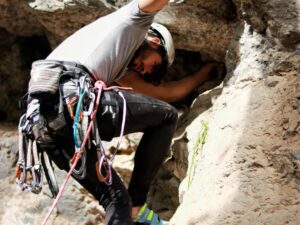To beginners in the climbing business, every climbing harness might look the same, but if you don’t understand how to choose the perfect harness, you might end up regretting that choice. Choosing the right gear is, without debate, very crucial in ensuring your preparedness and safety and ultimately needed to enjoy the exhilarating experience the adventure gives you.
So for those new ones, don’t worry! You’ll find all the answers to your questions about the climbing harness. In this article, you’ll know;
- What a climbing harness is
- The different types of climbing harnesses
- How to choose the correct harness for your preferred practice
- Other types of harnesses worth mentioning
- How to test a climbing harness’s size and comfortability
- Whether harnesses have weight limits
- The difference between a rock climbing harness and a tree climbing harness, and
- When to replace your climbing harness
What is a climbing harness? What are the types of climbing harnesses?
A climbing harness is a device made with strong webbing that typically has a padded waist belt and two leg loops connected at the front and back of the body. It is used to secure a climber to a rope. Below is an image of a typical climbing harness;
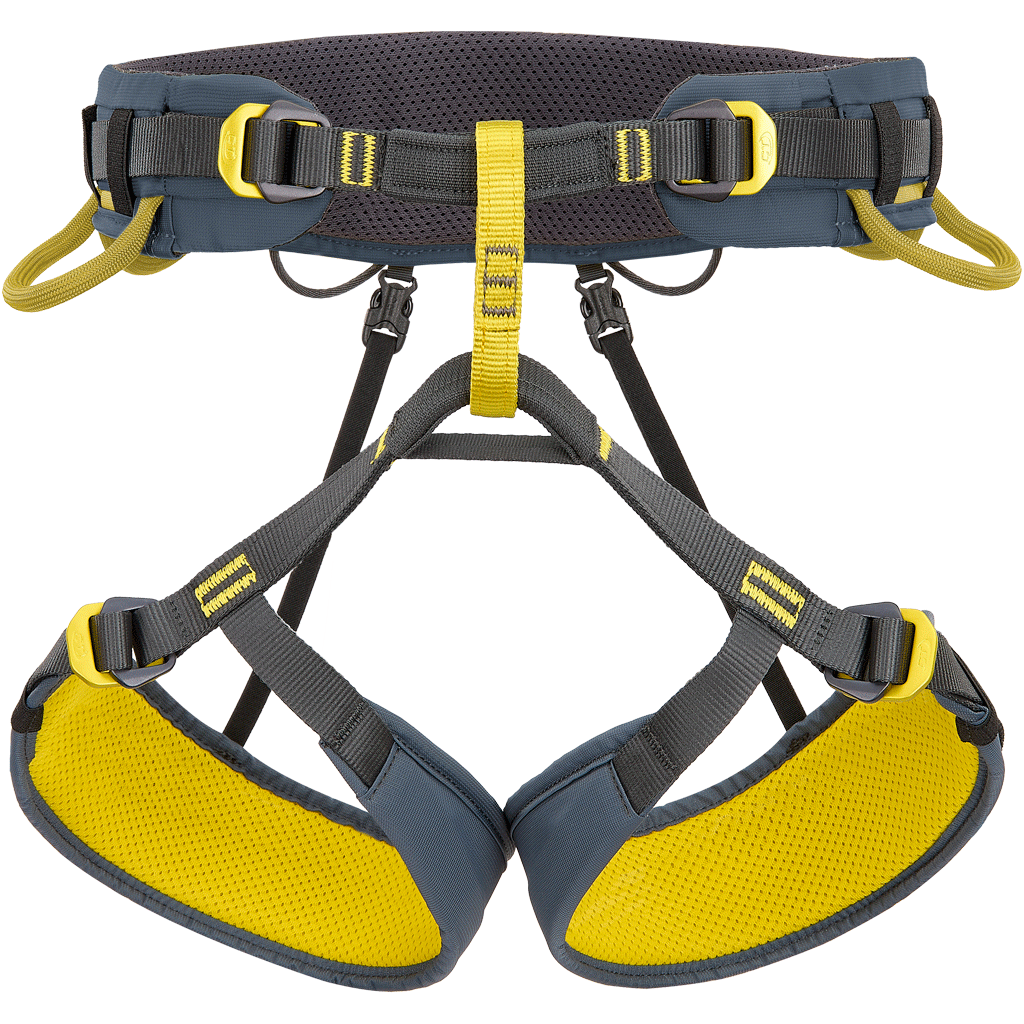

Climbing harnesses consist of the following parts:
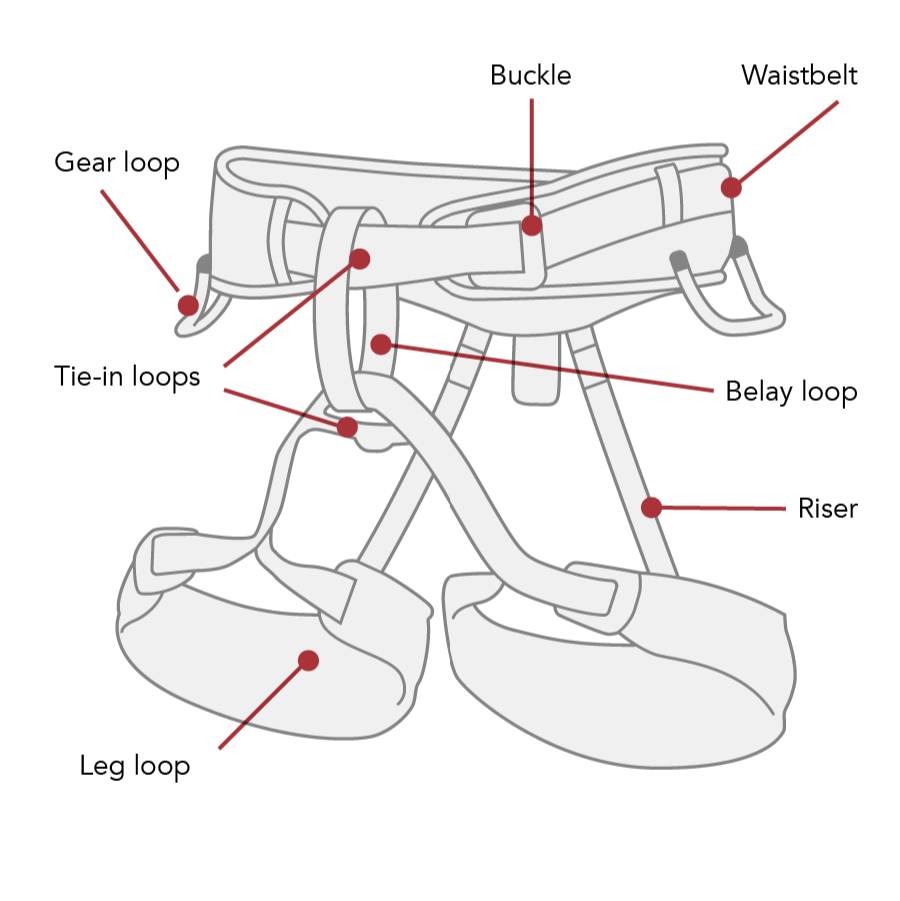
- Waistbelt – This is the wide opening at the top of the harness tightened above the waist to fasten the harness firmly to the climber.
- Leg loops – They disperse the climber’s weight and ensure comfort while hanging from the harness.
- Belay loop – It’s a robust loop at the front of the harness where the climber attaches the carabiner and belay device.
- Tie-in loops – These are the openings to which the belay loop is affixed. Climbers run their ropes through both of these openings when they are ready to climb.
- Risers – These straps adjust the distance between the leg loops and waistbelt.
- Gear loops – These loops only hold the climber’s gear, such as cams, quickdraws, stoppers, etc.
- Buckle – This is used to fasten your waistbelt firmly to your body frame.
Types of climbing harnesses
If you walk into a climbing gear store to buy a harness, you’ll see many types there. So it’s best to get acquainted with the different types and when they are used to save yourself some precious time.
The first thing you need to know is that in the climbing/mountaineering business, there is only one harness of interest: the sit harness. They are carefully designed for rock climbing, especially for long periods of suspension. While wearing it, the climber can rest in a sitting position while hanging from a climbing rope.
How to choose the right harness for your practice
Because the sit harness is the only harness of interest and climbing has several disciplines, it comes with various features to fit any climber’s preferred practice (or domain).
Sit harness for Sports Climbing
In sports climbing, the sit harness should have the following features;
- Very lightweight – For fast, ultralight movement.
- Few gear loops (about two) – Since minimal gear is required.
- Less padding – Since the climber doesn’t usually sit for long periods of time.
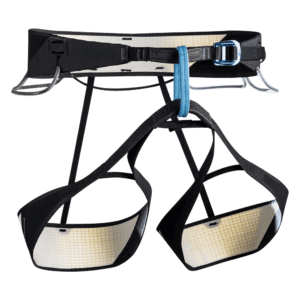
Sit harness for Multipitch routes
In multi-pitch routes, the climber is on the wall for a significantly longer period of time and would need more storage options for things like setting up belay stations. For this practice, the sit harness should have the following features;
- More gear loops (at least four) – Since the climb is more complex, more gear is naturally required.
- More padding – Not necessary but essential because of more extended periods of suspension.
Sit harness for Big walls
During big wall climbs, a lot of gear is hauled up the wall, and the climbers spend a lot of time belaying. For this practice, your sit harness should have the following features;
- Soft padding – Necessary for lengthy periods of suspension and belaying.
- Haul loop – For carrying a second rope.
- Wide leg loops – To withstand a lot of strain.
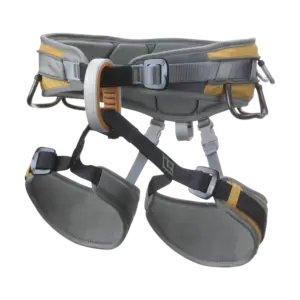
Sit harness for Via Ferrata
Via Ferrata, climbers need to move freely, like in sports climbing. Your sit harness should have the following features;
- Lightweight design – For full-range motion and ease of movement.
- Less padding – You don’t usually sit in the harness via Ferrata, so thick paddings are unnecessary.
Sit harness for Mountaineering or ski tours
These harnesses are not designed for lengthy periods of suspension, so they are not padded. For mountaineering or ski tours, your sit harness should have the following features;
- Ultralight design – They are very foldable to fit inside backpacks.
- Removable – They can easily be removed without taking off your crampons or skis.
- Wide leg loops – So you can wear thicker clothes.
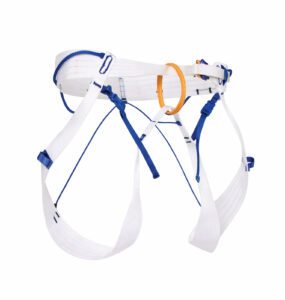
Sit harness for canyoneering
These harnesses are made explicitly for canyoneering and are suited for intensive use. Their key features include;
- Integrated protective seat – Protects your wetsuit and harness webbing from abrasion.
- Reinforced gear loops – For carrying heavier gear.
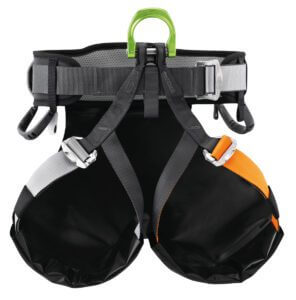
Other harnesses worth mentioning
- Chest harnesses: This harness is worn around the shoulders and is always used together with a sit harness. It’s designed to provide additional support and relief for the body’s core while on suspension. It’s usually used when a climber has a heavy load or is injured.
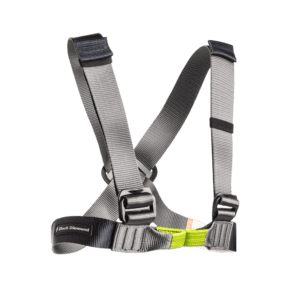
- Full-body harnesses: This is the combination of the sit and chest harnesses to form one harness.
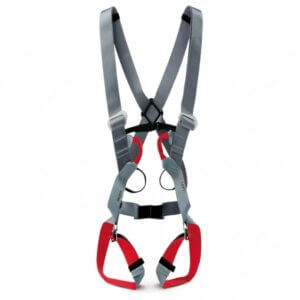
- Small body harnesses are very similar to adult harnesses but are designed for children.

How to try a climbing harness
Now that you know the various types of harnesses and when/where they are used, you can easily select which type would be best for you and test it for size and comfortability (N.B., the following steps apply to the sit harness).
How to wear a climbing harness
To put on a climbing harness, follow these simple steps;
- Loosen the leg loops (if adjustable) and waistbelt straps.
- Step into the harness. The leg loops should not cross, the belay loop should be at your front and not twisted, and the waistbelt should not be upside down.
- Tighten the waistbelt securely right above your hips.
- Allowable slippage between your waist and the harness is 20mm (2–finger gap).
- Make sure the buckle is doubled back (not necessary for auto double–back models).
- Adjust the leg loops (if adjustable). Some are elastic.
- Situating the leg loops close to the groin usually works best for prolonged hang times.
- Finally, ensure the buckles on each leg loop are doubled back.
How to test the size of a climbing harness
To test if a harness is a perfect fit for you, there are two significant parts to check — the waistbelt and the leg loops. If you are new to climbing, it’s advisable to ask a climbing assistant to guide you through the following steps;
The waistbelt
- Put on the harness. Adjust the waistbelt to the maximum limit. Consider trying a different harness if it still digs in too hard on your skin.
- The waistbelt should not move or shift excessively. If it does, tighten it until it stops.
- You can also test the waistbelt for slippage by trying to pull it down over your hips or slowly inverting yourself while hanging from a rope. The waistbelt should not be able to slip over your hips.
The leg loops
You should be able to slip your hand between your leg and the leg loop.
How to check for comfort
Many climbing gear stores have harness testing stations or rock walls that test whether any harness is a perfect fit for a climber. We strongly advise that you go to a store with one so you can take all the necessary steps to pick the correct harness. To test a climbing harness for its comfortability;
- When you hang from a harness, you should be able to sit upright in a relatively comfortable position, similar to a chair. However, you shouldn’t use too much of your core to maintain an upright position.
- You’ll want to adjust the risers if it proves too challenging to keep your body upright.
- Shorten the risers to help you sit upright with more ease while hanging.
- If the risers don’t help, consider trying a different harness.
Some other frequent questions about climbing harnesses
Do climbing harnesses have weight limits?
Yes, they most certainly do. And the limit is far greater than the heaviest human weights. For example, climbing harnesses that are CEN or UIAA certified have a weight limit of 3372.13 pounds which is about 20 times the average weight of a full-grown adult.
What is the difference between rock climbing and tree climbing harness?
A rock climbing harness is not the same as that of tree climbing. Tree-climbing harnesses differ from rock climbing harnesses in the following ways;
- They have thicker padding and softer material than most rock climbing harnesses.
- The tree climbing harness generally doesn’t have adjustable loops. They are designed to be more fitted and sleek. This makes them very comfortable and suitable for climbing trees.
When do I need to replace my climbing harness?
There are three main factors to consider when deciding if you should replace your climbing harness.
Change in body size
If your body size changes significantly, your harness will fit differently. Then you’d start to feel discomfort every time you use it. If this discomfort becomes unbearable for you, then it’s time you replace your harness.
How old the harness is
The average lifespan of a climbing harness for most brands is ten years from its manufacture date or five years after its first use. But if you’re a climbing professional, i.e. you climb full time, then it’s best you retire your harness as early as one year after its first use, even if there is no visible sign of damage.
Signs of excessive wear and tear
If your harness shows any signs of excessive tears, fraying, damage to the belay loop or structural webbing of the harness, then retire it IMMEDIATELY.

